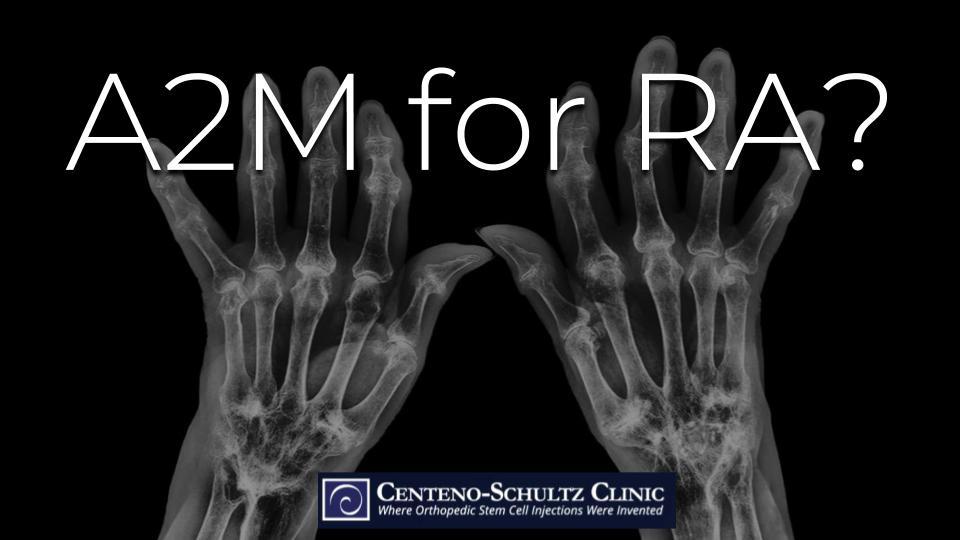We sometimes use the A2M protein to treat patients with knee swelling and to provide cartilage protection in those with osteoarthritis. A recent study, however, suggests A2M may also protect cartilage in those with a much different type of arthritis: rheumatoid arthritis.
What Is Rheumatoid Arthritis?
Rheumatoid arthritis (RA) falls under the umbrella of autoimmune diseases. In those with an autoimmune disease, the body’s immune system doesn’t recognize certain structures in the body and attacks them as it would a foreign invader, such as a bacteria or parasite. RA can be very debilitating as it progresses, and there is no cure for the disease, so the goal is to take measures early in the disease to control it as much as possible and ease its symptoms. Symptoms include joint pain and stiffness, swelling, and decrease in function.
When we typically talk about arthritis on this blog, in general, osteoarthritis is our focus. In contrast to RA, osteoarthritis (OA) is a joint problem due to gradual wear and tear that results in degeneration of cartilage in the affected joint. It is most common with aging. Today, however, we are focusing on rheumatoid arthritis.
Unfortunately, for RA patients, treatment to attempt to control the disease involves pharmaceuticals that are extremely toxic to the body, such as immunosuppressants. These are prescribed to attempt to stop the immune system from attacking its own native tissues, in this case its own joints.
A2M and Its Benefit to Osteoarthritis
Alpha-2-macroglobulin (A2M) is a large protein in the blood serum that can inhibit certain chemicals that break down tissue. One of these chemicals is known to break down collagen and progress arthritis, and that is the protein MMP-13. So in recent years, after a study found A2M could help reduce cartilage breakdown, A2M has been used to treat arthritis. Digging into the chemistry a bit, in the image to the right, the ball is an MMP-13 molecule. The MMP-13 is trapped on either end of the A2M structure. So as you can seen in the diagram, one A2M molecule (our good guy) can actually eliminate two MMP-13 molecules (our bad guys).
We sometimes use A2M for osteoarthritis treatment, but before we began using it, we tried many different methods via our flexible lab platform, testing the pros and cons of each. Finally, after concentrating it to many times over the baseline, we were able to create and validate an A2M protocol. What types of patients do we treat with this A2M-rich serum? Patients with severe joint swelling who have metabolic syndrome have had good responses to this treatment. Joint swelling is common in metabolic syndrome as obesity is typical with metabolic syndrome, which puts more pressure on the joints. In rare cases when osteoarthritis patients don’t respond well to high-dose platelet-rich plasma, we’ve also seen A2M work well in these types of patients.
We also use A2M as a chondroprotectant. An example would be in a patient with mild arthritis who wants to stay very active. We may inject A2M and PRP to attempt to increase cartilage production (PRP) as well as reduce or stop cartilage breakdown (A2M).
Now, it seems A2M may not be limited to just osteoarthrtitis as a recent study shows it may be useful in rheumatoid arthritis as well.
A2M May Protect Cartilage in Rheumatoid Arthritis
A recent study was a randomized controlled trial using three groups of mice. Two groups were injected with A2M doses ranging from 0.4–1.2 μg, and the third was a control group (injected with saline). All mice had collagen II-induced arthritis (this is similar to rheumatoid arthritis in humans). They studied inflammation, cartilage, and bone damage at various time points. Compared to the control group, the A2M groups had decreased inflammation as well as less cartilage and bone damage.
A2M is one of many orthobiologics we utilize in interventional orthopedics to treat musculoskeletal conditions, such as osteoarthritis. It will be interesting to follow this newest finding to see if A2M becomes useful as a treatment option for cartilage protection in rheumatoid arthritis as well.
